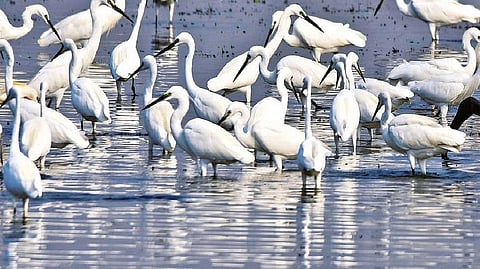

CHENNAI: Tamil Nadu is now the first State to have 10 Ramsar sites, which is the highest in the country.
The Union government on Thursday added 6 more sites to the existing list in Tamil Nadu.
India and China now have the most number of wetlands of international importance with 10 more Indian sites entering the Ramsar list, taking the total to 64, says Union Environment Ministry.
India is aiming at getting a Ramsar tag for 75 of its wetlands on the 75th year of Independence, according to officials.
Check out the list of Ramsar sites in Tamil Nadu:
1. Pallikaranai Marshland in Chennai
2. Karikili in Chengalpattu
3. Pichavaram in Cuddalore
4. Koothankulam Bird Sanctuary in Tirunelveli
5. Gulf of Mannar Marine Biosphere Reserve near Rameshwaram
6. Vellode Bird Sanctuary in Erode
7. Vedanthangal Bird Sanctuary in Chengalpattu
8. Udhayamarthandapuram Bird Sanctuary in Tiruvarur
9. Vembannur Wetland Complex in Kanniyakumari
10. Point Calimere Wildlife and Bird Sanctuary in Nagapattinam
What is Ramsar site?
The Ramsar list aims at developing and maintaining an international network of wetlands, which are important for the conservation of global biological diversity and for sustaining human life, through the maintenance of their ecosystem components, processes and benefits.
The sites include mangroves, marshes, rivers, lakes, deltas, floodplains and flooded forests, rice fields, coral reefs, and marine areas which are no deeper than 6 meters at low tide. It also includes human-made wetlands such as waste-water treatment ponds and reservoirs.
Ramsar Convention
The Ramsar Convention is an international treaty for the conservation and sustainable use of wetlands. It was signed in 1971 in the Iranian city of Ramsar. The negotiations to safeguard wetlands were started in the 1960s by different countries. It came into force in 1975. There are 51 Ramsar Sites in India listed under Ramsar Convention.
Evolution of Ramsar Convention
1962: MAR Conference called for an International Treaty for wetlands
1963-1970: Text for the Ramsar Convention was negotiated
1971: Ramsar Conference took place and 18 nations agreed to the convention on wetlands of International importance especially as waterfowl habitat
1974: Australia was the first country to accede to the convention
1974: First Ramsar site, declared - Australia's Cobourg Peninsula.
1975: Convention came into force
1981: India became the contraction party to the convention - Chilika Lake & Keoladeo National Park declared Ramsar sites.
Nine criteria to be fulfilled to get the recognition:
Criterion 1: If a site contains a representative, rare, or unique example of a natural or near-natural wetland type found within the appropriate biogeographic region.
Criterion 2: If a site supports vulnerable, endangered, or critically endangered species or threatened ecological communities.
Criterion 3: Site supporting populations of plant and/or animal species important for maintaining the biological diversity of a particular biogeographic region.
Criterion 4: Site should support plant and/or animal species at a critical stage in their life cycles, or provides refuge during adverse conditions.
Criterion 5: If site regularly supports 20,000 or more waterbirds.
Criterion 6: If site regularly supports 1% of the individuals in a population of one species or subspecies of waterbird.
Criterion 7: A significant proportion of indigenous fish subspecies, species or families, life-history stages, species interactions and/or populations that are representative of wetland benefits and/or values and thereby contributes to global biological diversity.
Criterion 8: If the site is an important source of food for fishes, spawning ground, nursery and/or migration path on which fish stocks, either within the wetland or elsewhere, depend.
Criterion 9: Site should regularly support 1% of the individuals in a population of one species or subspecies of wetland-dependent non avian animal species.
Look at the complete list of Ramsar sites in India:
Andhra Pradesh - Kolleru Lake
Assam - Deepor Beel
Bihar - Kabartal Wetland
Gujarat - Nalsarovar Bird Sanctuary
Himachal Pradesh - Chandertal Wetland, Pong Dam Lake, Renuka Wetland
Jammu & Kashmir - Hokera Wetland, Surinsar-Mansar Lakes, Tsomoriri, Wular Lake
Kerala - Ashtamudi Wetland, Sasthamkotta Lake, Vembanad-Kol Wetland
Goa - Nanda Lake
Leh-Ladakh - Tso Kar Wetland
Madhya Pradesh - Bhoj Wetland, Sirpur Wetland
Maharashtra - Nandur Madhameshwar, Lonar Lake
Manipur - Loktak Lake
Odisha - Bhitarkanika Mangroves, Chilika Lake, Satkosia Gorge
Punjab - Harike Lake, Kanjli, Ropar, Keshopur-Miani Community Reserve, Nangal Wildlife Sanctuary, Beas Conservation Reserve
Rajasthan - Sambhar Lake, Keoladeo National Park
Tamil Nadu - Pallikaranai marshland, Karikili, Pitchavaram, Koothankulam Bird Sanctuary, Gulf of Mannar Marine Biosphere Reserve, Vellode Bird Sanctuary, Vedanthangal Bird Sanctuary, Udhayamarthandapuram Bird Sanctuary, Vembannur Wetland Complex, Point Calimere Wildlife and Bird Sanctuary
Karnataka - Ranganathittu Bird Sanctuary
Tripura - Rudrasagar Lake
Uttar Pradesh - Upper Ganga River (Brijghat to Narora Stretch), Saman Bird Sanctuary, Samaspur Bird Sanctuary, Sandi Bird Sanctuary, Sarsai Nawar Jheel, Nawabganj Bird Sanctuary, Parvati Arga Bird Sanctuary, Sur Sarovar
Uttarakhand - Asan Conservation Reserve
West Bengal - Sundarban Wetland, East Calcutta Wetlands
Visit news.dtnext.in to explore our interactive epaper!
Download the DT Next app for more exciting features!
Click here for iOS
Click here for Android